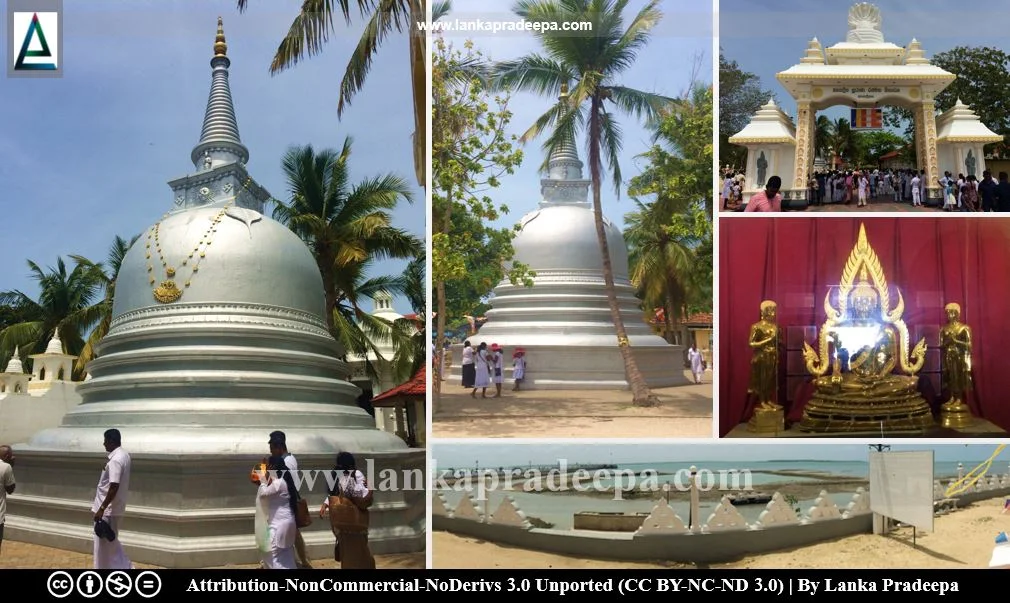
Nagadeepa Viharaya (Sinhala: නාගදීප විහාරය) is a Buddhist temple situated on the island of Nagadeepa/Nagadipa (Tamil: Nainativu) in Jaffna District, Sri Lanka. The famous religious shrines, Nagapooshani Amman temple, and the Buddha Walawwa are also located near to this temple.
History
Ancient Nagadeepa
Nagadeepa is referred to as Manipallavam or Maninaga island as well (Dias et al., 2016). The place is mentioned in several early Sri Lankan chronicles such as Dipavamsa and Mahavamsa and in ancient Tamil Sangam literature of Tamil Nadu (India) such as Manimekhalai.
Nagadeepa is first mentioned in connection with the story of the Buddha's second visit to Sri Lanka (Nicholas, 1963). The inhabitants of here were Nagas who are said to have been related to the ruling Naga family at Kelaniya (Nicholas, 1963).
Legends
According to Sri Lankan chronicles such as Mahawamsa, the Buddha in the fifth year after his enlightenment visited Nagadeepa in Sri Lanka to settle a dispute that had arisen between two royal kinsmen of the Naga clan Chulodara and Mahodara (nephew and uncle) over a gem-studded throne (Wijebandara, 2014). After the appearance of the Buddha, the Nagas who were about to war with each other stopped the war and paid homage to the Buddha (Wijebandara, 2014).
A deity named Samidhi Sumana who was residing in a Rajayathana tree (Kiripalu tree) adjacent to the Jetavanarama temple (at the time Buddha was living in Jetavanarama temple) is said to have come to Nagadeepa with the Buddha by holding his uprooted residence-the Rajayathana tree as an umbrella (parasol) to him.
The Indian Tamil epic Manimekhalai also describes the Buddha's intervene in settling a dispute between two Naga princes over a gem-set throne seat on an island known as Manipallavam.
Royal patronage
The Buddha is said to have returned to Jetavanarama leaving behind the gem-studded throne and the Rajayathana tree for the veneration of the Nagas. In the second century A.D., King Bhatikatisa (143-167 A.D.) is said to have built the Palu-da-ge at the foot of the Rajayathana tree and King Aggabodhi II (571-604 A.D.) had erected the Unnalomaghara dwelling to the Rajayatanadhatu Vihara (the Palu-da-ge and the Rajayatanadhatu Vihara are the same) as well as an umbrella for the Amala Cetiya (Nicholas, 1963).
Modern temple
The establishment of the modern Nagadeepa temple was pioneered by a Buddhist monk named Randombe Somasiritissa Thera who visited the site for the first time in 1939 (Vijithadhamma Thera, 2012; Wijebandara, 2014). In the following year, he met lady devotee Mallika Seneviratna at Bambarakele Sri Maha Viharaya in Nuwara Eliya, and with the help of her husband D.A. Seneviratna, the construction works of the modern temple were commenced in the present site in 1940 (Vijithadhamma Thera, 2012). The Stupa of the temple was unveiled in 1943 (Vijithadhamma Thera, 2012).
A gold-plated Buddha statue donated by the Myanmar Navy was placed in Nagadeepa temple in 1955 (Vijithadhamma Thera, 2012). As a result of the communal unrest that erupted in 1958, this statue as well as the other establishment of the temple including the Stupa were destroyed and vandalized by the locals (Vijithadhamma Thera, 2012; Wijebandara, 2014). However, the temple was restored with the support of the then government (Wijebandara, 2014).
The temple was again threatened in the 1980s due to the activities of the "Liberation Tiger of Tamil Eelam" (LTTE), a Tamil secessionist group designated as a terrorist organization by a number of countries (Vijithadhamma Thera, 2012). On 31 March 1986, the image house of the nearby Buddha Walawwa temple was destroyed by a bomb planted by the LTTE rebels (Vijithadhamma Thera, 2012).

.
References
1) Dias, M.;
Koralage, S.B.; Asanga, K., 2016. The archaeological heritage of Jaffna
peninsula. Department of Archaeology. Colombo. pp.201-202.
2) Nicholas, C. W., 1963. Historical topography of ancient and medieval Ceylon. Journal of the Ceylon Branch of the Royal Asiatic Society, New Series (Vol VI). Special Number: Colombo. Royal Asiatic Society (Ceylon Branch). p.83.
3) Vijithdhamma Thera, 2012. Nagadeepaya Eda-Ada (In Sinhala). Published by the author. pp.24-43.
4) Wijebandara, I.D.M., 2014. Yapanaye Aithihasika Urumaya (In Sinhala). Published by the editor. ISBN-978-955-9159-95-7. pp.81-89.
2) Nicholas, C. W., 1963. Historical topography of ancient and medieval Ceylon. Journal of the Ceylon Branch of the Royal Asiatic Society, New Series (Vol VI). Special Number: Colombo. Royal Asiatic Society (Ceylon Branch). p.83.
3) Vijithdhamma Thera, 2012. Nagadeepaya Eda-Ada (In Sinhala). Published by the author. pp.24-43.
4) Wijebandara, I.D.M., 2014. Yapanaye Aithihasika Urumaya (In Sinhala). Published by the editor. ISBN-978-955-9159-95-7. pp.81-89.
Location Map
This page was last updated on 6 June 2022
For a complete tourist map follow this link: Lankapradeepa Tourist Map
For a complete tourist map follow this link: Lankapradeepa Tourist Map

